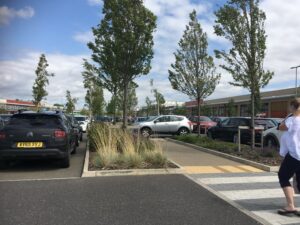Turning financial liabilities into assets through ecological recovery? We learn how habitat creation at scale is delivering Biodiversity Net Gain requirements and invaluable revenue for councils, farmers, and other landowners.
If a recent Defra report into public opinion surrounding nature is anything to go by, Britons are becoming increasingly conscious about the need to nurture flora and fauna. Which isn’t surprising, considering the country ranks amongst the worst on the planet for biodiversity.
From insect hotels to bird boxes, lawns let to grow free of constraints to encourage wildflowers and houses for hedgehogs, UK gardens are becoming greener. And more ecologically balanced. En masse, the impact over time could be profound, but widespread nature recovery is only going to be possible at a significantly larger scale.
Introduced as law last year, Biodiversity Net Gain legislation was widely seen as one of the most far-reaching pieces of environmental regulation anywhere in the world. The concept is relatively simple – if you’re developing land there is now a requirement to measure the existing level of biodiversity, and once the project completes add 10 points to the total. In short, leave the location in a better ecological state than it was found.
Implementation is much more complicated, of course. Developers, including the Local Planning Authority [LPA], can’t always meet responsibilities on site. Which is where habitat units and organisations like Environment Bank come in. But we’ll let the firm’s Associate Ecologist, Matt Dodds, explain more.
‘Local Planning Authority Engagement is my primary focus. So that involves liaising with places we have worked with before, where a new habitat bank is coming forward, or those that have contacted us,’ he tells us. ‘We want them to know how we work, what they can and are planning for, and how the site will be managed. There are a lot of local priorities to take into account, and also a lot of specialists that we can connect them to to deliver what’s needed.
‘A habitat bank is a ‘Lawtonian solution’ to the nature crisis – it stems from the Lawton report,’ Dodds continues, citing a 2010 review, ‘Making Space for Nature’, which concluded England’s wildlife sites and ecological networks were not resilient, coherent or sufficiently protected. The recommendation was to shift from conservation and site protection to expansion and restoration of large areas of land. ‘A habitat bank creates a large area – we typically look at 20 hectare blocks – which we can create natural habitats on before a development takes place.’
Once the bank is in place, developers – public and private – can buy parts of this in order to accrue enough points to meet Biodiversity Net Gain targets. This funding then ensures the habitats can be maintained and safeguarded for 30 years. Sites are chosen based on their ecological viability and suitability for other purposes, meaning low yield agricultural land, which requires intensive farming to turn a profit, can be handed back to nature, allowed to recover, and the farmers can be financially compensated for this. The model is so robust it can offer a more reliable and predictable income.
‘I refer to it as life by a million cuts,’ quips Dodds. ‘Lower quality land – modified grassland, poor quality arable, anything like that would not have been measured in the previous system. They would have just been ignored. Now everything has to be measured, and you have to exceed that unit by 10%. There’s encouragement to do this on site, but often that’s not possible if the development is to be viable, as you have to leave too much of the land. So, often the solution is to go off site.’
While this may sound like a pitfall, Dodds is quick to add that this is actually more ecologically beneficial. Creating scaled up, biodiversity rich habitats is more in line with Earth’s natural makeup, and delivers a much bigger impact. We ask if this is more relevant to dense urban areas, the placemaking neighbourhoods of London and Manchester, where space is a premium and overheads are high. The response is surprising.
‘It works at all levels, but in terms of smaller developments these are the ones that need off-site resources more. In order to be viable and small, they need to develop most of the site. So there isn’t the space for Biodiversity Net Gain to be met. So it’s these lower density projects that often take up the most units in nature banks,’ says Dodds.
‘A habitat bank works for all development scales,’ he continues. ‘The larger developments generally are more likely to be able to wash their own face, because they’ve got the scale to do so. But even in those situations, there’s a big argument for purchasing offsite units on a large, ecologically well-connected habitat bank rather than putting units in small isolated pockets on a development site.’
Painting a picture of a symbiotic relationship between developers, planners and nature itself, the truth is that off-site banks and biodiversity credits are usually the more effective solution. Providing there’s a suitable local market. Demand for development needs to be at a level that warrants the investment needed to create large scale habits and sell enough parts of these to maintain the site in the medium term. With Britain on the brink Labour’s promised house-building bonanza, it seems likely this balancing act will become easier to achieve in more widespread parts of the country.
The advantage for planning authorities goes further still. With low quality land often considered a financial liability, habitat banks have the capacity to turn these sites into a revenue-generating asset. And organisations like Environment Bank, Dodds proudly claims, mean there’s little-to-no resource implication for an already time-starved public sector. ‘They don’t have to try and create a habitat bank from scratch, with no knowledge, no understanding of the process.
‘The first step is looking at our website, seeing what we do and then arranging an initial meeting. We take that forward and see what land is available in the area. Then we assess it. Some might not be suitable, we have parameters and work to location,’ he continues. ‘We don’t want to be putting habitat banks on highly productive farmland. So it needs to be marginal, well located, and we need to make sure the market is able to sustain that habitat bank. Then it’s a case of design – surveying to understand what habitats can exist there, how many units are possible to make it self-sustaining, and making the authority an offer. If they’re happy, we prepare for submission to the National Register, and start selling units.’
Success stories are now far and wide, with more than £1.5million in habitat units now sold to 20 planning authorities, in addition to private developers. These range from 35 acres of ‘low productivity’ farmland in Hartlepool, where the council and companies including Bellway, Miller Homes and Keepmoat need to build 400 homes per year to keep up with demand, to golf courses in major cities which are no longer turning a profit, with most cases allowing existing tenants to stay on loss-making land and generate new income.
Image: Preparing for a new habitat bank in Hartlepool / Environment Bank
More features:
Could UK innovators help ‘turn back the clock’ on Earth Overshoot Day?
Sustainable palm oil can plant seeds to balance people and place
The Big Interview: Tom Grylls – Clean Air Fund’s Head of Super Pollutants

















